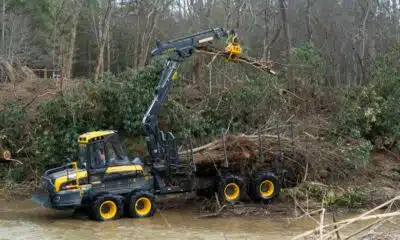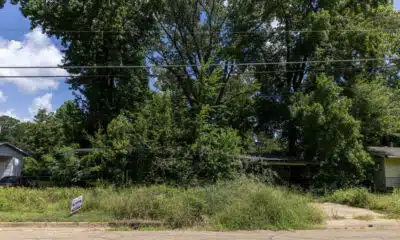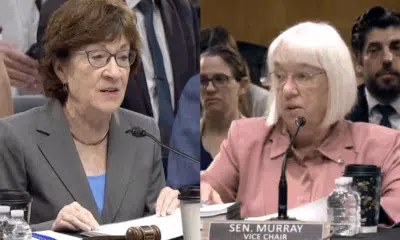News from the South - North Carolina News Feed
George Dixon, renowned blacksmith; Michael and Nora Drye, and their grandson, Micah • Asheville Watchdog
Asheville Watchdog is bringing you the stories behind the staggering loss of life from Helene, the children, parents, grandparents, multiple generations of a single family, all gone in one of the worst natural disasters to hit the mountains of western North Carolina. This is the sixth installment.
Jill Dixon hunkered in her husband’s office in their Swannanoa home, clinging to their two dogs, as the water from the Bee Tree Creek breached its banks and rapidly rose toward the house and then inside.
“The water came up higher and higher and higher, and I was yelling for help,” she said. “The water was up to almost my shoulder…and George didn’t answer.”
George Dixon, 72, had gone into a bedroom in the back of the house to retrieve car keys and evacuate his family. Torrential rains from Tropical Storm Helene Sept. 27 had turned the creek into raging floodwaters.
Read previous installments of The Lives We Lost.
In a matter of minutes, the water had ripped the back of the Dixons’ home off its foundation, sweeping away a back bedroom with George Dixon in it.
“Somehow, I don’t know how, he made it around to the front and was hanging on to a tree in the front yard and then another big gush of water came really deep, very forceful,” Jill Dixon said. “Trees were falling everywhere, and he got swept away again, and that was the last time I saw my husband.”
With the water inside the house several feet deep, Jill Dixon, 69, climbed onto a dresser with her dogs. Her 40-year-old daughter and two grandsons, 19 and 17, one of whom is autistic and uses a wheelchair, floated on a mattress, she said.
“I was trapped in there, probably for five or six hours, and I was having hypothermia, shaking, chills, blue lips, blue nail beds,” she said. “The water was getting deep, so we kicked out the window to get some of the water out … and it was really scary.”
A neighbor finally reached them, traversing washed out roads and bridges. ”There were so many trees down that the neighbor had to use a chainsaw and cut a tunnel through the trees to get me out,” Jill Dixon said.
Her husband’s body was found two days after the storm, buried in mud, but Jill Dixon said he was not positively identified until Oct. 13, two weeks later. “I was so worried and so upset,” she said. “I kept wondering where he was.”
Highest honor in blacksmithing
Dixon was a renowned blacksmith described by fellow artists as among the best in the country.
“He did everything from big chandeliers, iron gates, the old way blacksmiths did it,” his wife said. “Everything was handmade, hand sanded, very detailed, and he had the most complete blacksmith shop in the United States.”
Dixon had been head blacksmith at Samuel Yellin Metalworkers in Philadelphia before moving to Swannanoa in 1992. He helped restore the decorative iron and metal works of Yellin, the country’s premier 20th century blacksmith, whose pieces from the early 1900s included commissions for the Federal Reserve Bank of New York, Yale and Princeton universities, and the Washington National Cathedral.

Dixon taught Yellin’s techniques at demonstrations throughout the country and was founder and editor of “the Traditional Metalsmith” and later “The Artist-Blacksmith,” quarterly publications dedicated to traditional methods of fine architectural ironwork.
Dixon received the 2019 Alex Bealer award, the highest honor from the Artist-Blacksmith Association of North America “for contributions to the blacksmith world,” said Leigh Morrell, the group’s former president.
He chaired the association’s best attended national conference, held in Asheville in 1998, that attracted blacksmiths from around the world, Morrell said.
“The guy was incredible,” said Morrell, who along with Dixon started the Historic Blacksmith Conservancy.
Dixon specialized in Gothic work, said Ernie Dorrill, a blacksmith and friend in Canton, Miss.
“Some of it was very small work, very tiny, like rivets, and some was rather large, like gates,” Dorrill said. “He did a lot of restoration of Yellin’s work,” including two lanterns at the Bank of Philadelphia, each weighing two tons.

Dixon’s love for blacksmithing began as a hobby, and he largely taught himself.
“George researched everything,” Dorrill said. “He said, ‘Look Ernie, these are the same tools they used 1,000 years ago, and if you want to do good hand work, you’ve got to use the same techniques and technology.’
“He was brilliant, he really was,” Dorrill said “We’ve had a tremendous loss with George… It ripped a hole in my heart.”
Dixon had a shop in his house and was still working.
“It’s a real hard craft to learn, and it takes a long time,” his wife said. “But he was a very special guy, and that was pretty much his hobby, too, blacksmithing, that’s what he did. His whole life centered around that.”
Dixon was writing his third book, Jill Dixon said.
“We help each other out”
A blacksmith friend and Dixon’s son are hoping to salvage his work from a computer that was damaged in the floodwaters, Dorrill said. They’ve also been sifting through mud to recover Dixon’s tools and drying water-soaked drawings.
“He was a superb illustrator,” Dorrill said.
Jill Dixon said she’s grateful to the support of her husband’s blacksmith community and her neighbors along Bee Tree Road.
After she was rescued, Dixon said one neighbor “was nice enough to give me some dry clothes and a place to sleep overnight and some food.”
“It’s been truly an outpouring of caring for each other that’s part of the community up there,” she said. “We help each other out. It’s a lot of Christian people around you, the Bible Belt area.”
Dixon said her pastor took her in for several nights. Their church, Bee Tree Christian Church, founded in 1872, was also severely damaged in the storm.

Dixon said she went two days without water.
“I have to give myself heart medicine, and I have to, every week, give myself a shot because of rheumatoid arthritis,” she said. “I went without any medicine for over three weeks. I could hardly walk by that time.”
Dixon was stunned when she saw the widespread devastation from Helene.
“It was so traumatic for me to see whole neighborhoods swept away – holes, massive, deep holes in the ground, trees down everywhere. People were desperate for food, water, clothing,” she said.
She’s leaning on her faith to cope with her enormous loss.
“I thank the good Lord that I lived through it, because I could have drowned very easily,” Dixon said. “I was rescued, and my faith in God has gotten so much stronger since this experience.”
She salvaged two photos from the ruins of her home, the only ones she has left, including one of her and George. On Oct. 7, they would have been married 50 years.

Dixon is now staying with a friend in Raleigh.
“I’m trying to start over, but it’s been really difficult,” she said. “I lost my husband, I lost my car, everything … all my cards, my purse, all my records, documents that you have, everything, my antique furniture. I had a good Chinese collection of really old pieces.”
Dixon does not intend to return to the Asheville area. “I don’t want to ever go through something like that again,” she said.
The couple’s two dogs, Rally, a Pomeranian, and Loki, a mountain feist, survived the flood, but Dixon said she could no longer keep them.
“They went to an animal shelter,” she said. “They’ve been put up for adoption. It’s sad. I miss them, too, but … I’m accepting the realities I have right now.”
She said she has not yet received assistance from FEMA. A GoFundMe page to benefit her had raised nearly $18,000 as of Saturday.
Dixon said she’s keeping a positive attitude.
“I think each day will get a little bit better,” she said. “I get a second chance at life.”
Michael, Nora and Micah Drye
The deaths of Michael and Nora Drye, both 73, and their 7-year-old grandson, Micah, and the rescue of their daughter Megan Drye, 39, were broadcast almost in real time on Facebook. There, their daughter, Jessica Drye Turner, pleaded for prayers.
“My family is currently on the roof of their house in Asheville, NC with nothing but the clothes on their back and one working phone,” Turner wrote at 1:46 p.m Sept. 27. A little over half an hour later, she posted a photo of someone’s feet perched on a roof. Brown floodwaters were lapping at the eaves of the Dryes’ Swannanoa River Road home.

At 4:23 p.m., she updated the post with another photo. It was one of the last images of Nora Drye. She was looking out at the destruction.
Eighteen-wheelers and cars were floating by, the group of four reported via their one phone.
At 2:54 a.m. Sept. 28, Turner provided a horrifying update.
“[M]y parents and nephew drowned bc the roof collapsed,” she posted. “My sister got wedged btw something. She was rescued an hour later.”
Leaning on her faith, Turner typed out a mournful celebration of her parents’ life and a plea for Megan’s.
“The image I focus on every time I imagine that moment is how joyfully they are praising Jesus at his feet, dancing with renewed bodies and not remembering how they passed,” she wrote. “I plead to Jesus to hold my sister tightly. God is faithful. Just. Weeps and mourns when we do and comforts us in our times of need. He rescued my parents and nephew in his way and took them home.”
Nearly 12 hours later, Turner reported she had located Megan. Someone called a local hospital, connected with a nurse who brought the phone to Megan, allowing her to speak with her family.
On Sept. 29, Jessica and her sister drove to Asheville and picked up Megan.
Nora Drye’s body was found nearly two miles from Micah’s and Michael’s in Biltmore Village, according to death certificates. Micah’s body was found Sept. 30, Michael’s on Oct 1, and Nora’s on Oct. 5.
The cause of Michael’s death was listed as a “landslide injury.” Micah and Nora’s cause of death was drowning, according to the death certificates.
Turner would return to the same Facebook post, updating it more than 20 times through Oct. 10, returning with more details about exactly what happened to her parents and nephew as recalled by Megan.
“The roof did not collapse, the house did,” Turner wrote in an Oct. 1 update, describing the ensuing panic and terror as the floodwaters took her family, one by one, sparing only Megan, who let herself float away and became lodged between two trailers before someone saw her.
Megan and Jessica told their stories to numerous news outlets, launching the story to international attention. Asheville Watchdog reached out to the family but was not able to connect for an interview.
Michael was an attorney and mediator for over 40 years, according to a joint obituary for the couple and their grandson. He “left a legacy of compassion and care in helping clients, friends, and family navigate the legal complexities of some of the most difficult seasons of their lives.”

In May 17 he was honored by the North Carolina State Bar for being a board certified family law specialist continuously for 30 years, according to his LinkedIn profile.
Nora was “a lover of life and devoted mother of three girls. [She] inspired many by being an unwavering example of living an active, pure, peaceable, and quiet life,” the obituary said.
The two were members and leaders at Biltmore Church, according to a report from Religious News Service.
“Micah will be remembered for his vibrant energy, his gentle and affectionate spirit, and his relentless pursuit to become a superhero, which he did,” the obituary said.
A memorial service for the three is set for Monday at Biltmore Baptist Church.
– Andrew R. Jones, Asheville Watchdog
Asheville Watchdog is a nonprofit news team producing stories that matter to Asheville and Buncombe County. Sally Kestin is a Pulitzer Prize-winning investigative reporter. Email skestin@avlwatchdog.org. Andrew R. Jones is a Watchdog investigative reporter. Email arjones@avlwatchdog.org. The Watchdog’s local reporting during this crisis is made possible by donations from the community. To show your support for this vital public service go to avlwatchdog.org/support-our-publication/.
Related
The post George Dixon, renowned blacksmith; Michael and Nora Drye, and their grandson, Micah • Asheville Watchdog appeared first on avlwatchdog.org
News from the South - North Carolina News Feed
Asheville’s Urban Forestry Commission speaks for the city’s trees. It hasn’t met since Helene. • Asheville Watchdog
Asheville’s Urban Forestry Commission met on Sept. 3, 2024, with an agenda that, if unexceptional, represented the kind of work the volunteer advisory board had done since its inception at the beginning of the decade.
Its members heard an update from Keith Aitken, who a year earlier had become Asheville’s forester after the UFC successfully lobbied the city to create the position. They voted to recommend the approval of a landscaping plan for a Duke Energy substation on Rankin Avenue. And they discussed the Urban Forest Master Plan, for which City Council had approved funding that June. Local environmentalists, including the UFC, had long advocated for a roadmap for protecting and growing the city’s canopy; now one was finally on the way, with a public tree inventory and satellite analysis ready to begin.
Then Tropical Storm Helene tore the urban canopy asunder. In its aftermath, the city paused work on the Master Plan and indefinitely suspended all advisory boards, including the UFC.
Eleven months later, the UFC still has not reconvened, the Master Plan is still on hold, and their purgatorial state is causing growing alarm among advocates who see this period of recovery as a particularly crucial moment for Asheville’s trees.
Though local tree loss has not been thoroughly quantified, the North Carolina Forest Service has estimated that 40 percent of trees in Buncombe County but outside the city limits were damaged; one analysis of hundreds of fallen trees within Asheville found that the city’s medium-to-large hardwoods fared particularly poorly. Meanwhile, one of the city’s largest contiguous forested areas is on the chopping block, as the University of North Carolina Asheville is pursuing a proposal to replace 45 wooded acres with a 5,000-seat soccer stadium and surrounding development.

“Of all the times when you really need (a master plan), you’d think now would be the time, when we’re trying to think of how to prevent the next disaster caused by too much pavement and too much building and not enough stormwater absorption and not enough green infrastructure,” said Steve Rasmussen, a member of the volunteer Tree Protection Task Force for Asheville and Buncombe County, which has worked closely with the UFC.
When the UFC formed in 2020, it was part of a focus on trees that local environmentalists felt was sorely needed; a study commissioned by the city the previous year had found canopy loss of more than 6 percent coinciding with population growth over the previous decade. The UFC’s predecessor, the Tree Commission, had a narrower purview, as did the canopy ordinance the city had in place for decades. Between the UFC’s inception and the post-Helene pause, according to UFC documents, the city preserved more than 2.5 million square feet of canopy, planted about 400,000 more, and collected roughly $300,000 in fees related to landscape compliance rules.
Aitken, the city forester, was not available for an interview for this story, city spokesperson Kim Miller said. In an email, Miller pointed toward the creation of Aitken’s position and to the 2020 city ordinance that expanded canopy protections.
“The master plan contract remains in place as staff assesses the next best steps forward,” she said. “We will announce the restart of the planning process and opportunities for community involvement in the coming months.”
The UFC doesn’t have to meet for the plan to move forward; the city has already chosen its contractor and approved $269,000 in spending, and as an appointed advisory board, the UFC weighs in on city matters but doesn’t have decision-making authority.
But keeping the UFC dormant could deprive the public of an important conduit to city officials, one more powerful than sending an email or speaking for three minutes during a council meeting’s public comment section, Rasmussen said.
“It really helps to have an advocacy group, and for people in general it really helps to have a place to take their concerns about trees and tree protections and have them addressed. The UFC has been one of the most active of all these boards and commissions.”
Zoe Hoyle, the UFC’s most recent chairperson, said the advisory board could play an important role in engaging the public as the city continues to respond to Helene and, eventually, restarts the Urban Forest Master Plan.
“I think it’s really important that we do something that marks us out as a city” in Helene’s wake, she said. “‘Transformative’ is the word I like to use.”
Alison Ormsby, the co-chairperson of the Tree Protection Task Force, said she would have liked to see the UFC continue to meet after Helene — helping to steer the city’s recovery as it pertained to trees and green spaces and acting as a watchdog as criticism proliferated over the debris-removal practices of the U.S. Army Corps of Engineers and its paid-by-volume contractors.
“Eric North, a program manager for the Arbor Day Foundation, which administers the Tree City program, said in an email Asheville began its application last year but, like some other communities preoccupied by hurricane recovery, didn’t finish it. who could provide really useful input on storm response,” she said.
Future of city’s advisory boards uncertain
The UFC’s uncertain future is part of a bigger question the city now faces: What will it do about its many advisory boards? It had 13 active ones before Helene and two others that existed in name but hadn’t met for years. The boards have been paused largely because city staff hasn’t had time to help them run their meetings.
At a City Council meeting last week, city staff offered one path forward, a plan to keep the advisory boards on hold and reassemble some of their members into four so-called recovery boards. Assistant City Manager Ben Woody said the proposed arrangement would be more efficient, and eventually the individual advisory boards could still meet or take on tasks as the city wishes.

The city’s Boards and Commissions Realignment Working Group has proposed an alternate plan in which it would voluntarily help publicize and run advisory board meetings. Councilmember Kim Roney supported the idea, saying she believed it’s time for the boards to get back to work.
“I don’t know everything about everything,” she said. “But when we invite our neighbors to bring their professional and lived experience to the table, we can make better decisions as a council.”
But City Attorney Brad Branham threw cold water on the idea. Though he stopped short of shutting it down entirely, he said he worried about the boards inadvertently violating open meetings laws in the absence of city staff. Such an error could cause legal trouble for the city, he said.
Those close to the UFC hold out some hope that the city will entertain the Realignment Working Group idea. Hoyle said she has concerns about the recovery-boards plan. She believes UFC members would need seats on all four boards to be effective. (A draft Woody presented last week has UFC members on the proposed Economy and Infrastructure boards — but not on the People & Environment board.) And while advisory boards could still be called upon for occasional work, Hoyle worries the lack of regular structure would undermine that expectation.
“Our current members could lose interest and just disappear,” she said. “I don’t know what the mechanism will be for replacing our membership.”
To some observers, the progress on tree issues in recent years now feels fragile. Even Asheville’s Tree City USA distinction, which it held for nearly 45 years, has lapsed. Eric North, a program manager for the Arbor Day Foundation, which administers the Tree City program, said in an email Asheville began its application last year but, like some other communities preoccupied by hurricane recovery, didn’t finish it. He said the Foundation would welcome the city’s reapplication this year.
But to meet Tree City standards, Asheville would need a functional tree-focused board or department.
“We no longer fit the criteria,” Ormsby said. “Some folks have said we don’t deserve it.”
Asheville Watchdog welcomes thoughtful reader comments about this story, which has been republished on our Facebook page. Please submit your comments there.
Asheville Watchdog is a nonprofit news team producing stories that matter to Asheville and Buncombe County. Jack Evans is an investigative reporter who previously worked at the Tampa Bay Times. You can reach him via email at jevans@avlwatchdog.org. The Watchdog’s reporting is made possible by donations from the community. To show your support for this vital public service go to avlwatchdog.org/support-our-publication/.
Related
The post Asheville’s Urban Forestry Commission speaks for the city’s trees. It hasn’t met since Helene. • Asheville Watchdog appeared first on avlwatchdog.org
Note: The following A.I. based commentary is not part of the original article, reproduced above, but is offered in the hopes that it will promote greater media literacy and critical thinking, by making any potential bias more visible to the reader –Staff Editor.
Political Bias Rating: Center-Left
The article presents a detailed account of Asheville’s Urban Forestry Commission and related environmental efforts, emphasizing local advocacy, preservation, and sustainable urban planning. The tone supports environmental protection and community involvement, topics often aligned with progressive or center-left priorities. However, it remains fact-focused and refrains from overt political rhetoric or partisan framing. It highlights concerns over government delays and environmental degradation without explicit ideological critique, reflecting a measured, policy-oriented perspective consistent with a center-left viewpoint focused on green issues and civic engagement.
News from the South - North Carolina News Feed
Trump’s executive order could worsen state’s involuntary commitment system
SUMMARY: President Trump’s executive order easing removal of homeless individuals into mental health or addiction treatment raises concerns among North Carolina advocates and experts. They fear the order could worsen the overused and harmful involuntary commitment system, which already traps many without adequate legal representation or treatment in overwhelmed emergency departments. Expanding criteria for commitment to include those unable to care for themselves may increase institutionalization beyond current state capacity. Advocates argue the order criminalizes homelessness and lacks housing solutions, violating civil liberties. They call for community-based prevention, peer support, and improved services rather than widespread forced commitments, which can do more harm than good.
The post Trump’s executive order could worsen state’s involuntary commitment system appeared first on ncnewsline.com
News from the South - North Carolina News Feed
Back-to-School meals don’t have to be boring
SUMMARY: Back-to-school meals don’t have to be boring. To help kids focus and perform well, breakfasts should include protein, healthy fats, fiber, and carbohydrates. Ideas include whole wheat toast with nut butter and fruit, breakfast burritos with eggs and veggies, or veggie-filled egg muffins prepared in advance. For lunch, homemade “Lunchables” with low-sodium meat, cheese, whole wheat crackers, veggies, and fruit offer nutrition and variety. Leftover pasta with veggies and hummus or chicken salad with fruit and crackers are healthy options. Always pack water for hydration, and keep cold foods safe with at least two cold packs in lunchboxes.
Back-to-school meals don’t have to be boring. Some healthy options for your children.
https://abc11.com/backtoschool/
Download: https://abc11.com/apps/
Like us on Facebook: https://www.facebook.com/ABC11/
Instagram: https://www.instagram.com/abc11_wtvd/
Threads: https://www.threads.net/@abc11_wtvd
TIKTOK: https://www.tiktok.com/@abc11_eyewitnessnews
-
News from the South - Texas News Feed6 days ago
Rural Texas uses THC for health and economy
-
Mississippi Today3 days ago
After 30 years in prison, Mississippi woman dies from cancer she says was preventable
-
News from the South - Alabama News Feed7 days ago
Decision to unfreeze migrant education money comes too late for some kids
-
News from the South - Georgia News Feed4 days ago
Woman charged after boy in state’s custody dies in hot car
-
Mississippi Today7 days ago
They own the house. Why won’t they cut the grass?
-
News from the South - Arkansas News Feed7 days ago
Trump’s big proposed cuts to health and education spending rebuffed by US Senate panel
-
News from the South - Georgia News Feed7 days ago
Delta jet makes emergency landing | FOX 5 News
-
Mississippi News Video7 days ago
Jones County investigators work to solve 2011 cold case












































